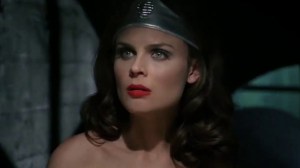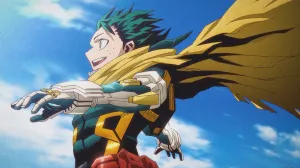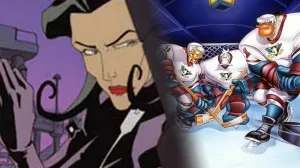Why art?
Videos by ComicBook.com
That’s a question we’ve all heard in some variety or another. It occurs in collegiate philosophy courses, high school English classrooms, and more message boards and social media platforms than it’s worth counting. It is a question that arises, even if only subtextually, whenever we discuss art, whether that’s a blockbuster motion picture like Black Panther or a new exhibit of paintings at a local gallery. The question is a constant in our lives, but the quality of its asking and answers varies greatly. Eleanor Davis frames both halves of that equation wonderfully in her newest comic that states its purpose on the cover: Why Art?
Davis carefully establishes the question in a series of increasingly complex phases throughout the comic. It opens with the simplest possible answers, putting forth key elements and styles of art. Size and color are noted with a few quick lines, as are masks and mirrors. Taken only as prose, the simplicity of this opening would seem childlike. Yet Davis is focused on the key element of her own artistic form comics as every sentence is juxtaposed with a single drawing. Color is stated next to black-and-white drawings. Readers are led to start questioning assumptions about these seemingly easy ideas through stark contrasts in words and images. Even as the comic begins in the shallow end of a very long pool, it encourages careful consideration to everything that is shown.
After grounding an approach to the question, Davis begins to delve into more controversial topics that surround art. It’s here that she illustrates concepts of purpose, artist-audience relationship, and escapism. There’s ample humor within many of her panels as well. Two audience members struggling over their unique relationships with art is framed in a slap. Davis does not distinguish between drama and comedy, allowing each to fill her examination in equal parts.

It’s at this stage that Davis’ prose is at its most poetic. No single page contains more than a few sentences, creating a balance with artwork that contains only the most essential lines. Yet the relatively spare words, just like the illustrations, belie the true complexity of what is present. Examining the ability of artwork to reveal dark and awful aspects of existence, Davis provides a striking bit of prose:
“But they are true, and being reminded makes us feel like the tops of our heads are coming off. It makes us feel like the sky is wrinkling and running like wet tissue paper, like we’re being dragged down into deep water by many drowning hands, and we have to tear and rip at the hands to make them let go.”
This is staging for the final and largest act of Why Art? which offers a narrative structure digging ever deeper into the question itself. Artists and their creations are quickly introduced as constructs for readers to see themselves, creators, and creations in different arrangements. The individuals within this narrative are no characters as much as they are projections for a metaphysical journey that grapples with the multi-faceted nature of the title.
Davis’ approach to the question is carefully balanced and provides the comic with more soul and thought in a handful of words and images than many classrooms may construct in hours of conversation. Rather than stating clear theses, Davis utilizes each pair of pages to reframe or re-contextualize an argument. Bold proclamations as to what is art have failed skilled critics like A.O. Scott in Better Living Through Criticism and created the most derided section of Scott McCloud’s watershed comic Understanding Comics. Davis cannot conceive of art in a singular definition and opts to engage it with deserved complexity instead. She is engaged in a Socratic conversation with her audience, eliciting responses to questions and statements, then moving onto new concepts that garner reconsideration.

If all of this evokes visions of a comic that is highfalutin or pretentious, it should be stated that Why Art? is nothing of the sort. The subject matter is weighty, but its construction in the comics form is designed to provide accessibility and open discourse on the topic. Like the best sort of educator, it uses a unique set of tools to make knowledge accessible without simplifying or dumbing down any element. It is a populist vision of the conversation surrounding art, even if some of the arguments put forth strive to see art treated more seriously and avoid the temptations of pure entertainment.
Davis’ greatest skill is her ability to distill complexity into the fewest lines and words possible. To call her cartooning simple would be to miss the point entirely. As a fine artist she discovers form and evokes ideas with the most carefully considered set of ideas. There is no unnecessary work on any of the pages in Why Art? and not a single place where additional detail is needed. This is comics minimalism at its absolute finest.
The result is a set of approximately 200 pages packed with ideas and infinitely accessible to a wide audience. Every person in these pages is a distinct individual with bold forms, shapes, and sizes. They manage to cultivate a collection of people that allows readers to see themselves and their world within the text. The artwork in the comic itself is abstracted or simplified to a level where it becomes a thought experiment. A blob of black ink stands for any sculpture in a museum, while the construction of a town can be found in a handful of houses and telephone polls. Davis incredibly specific experience in her last work You & A Bike & A Road has been transformed into the universal. There is no angle from which these people and their world do not function or appeal to lived experience.
Why Art? is the first transcendent comics work of 2018. It makes a bold statement about what art and comics are capable of. In broad strokes, it evokes a conversation with the reader concerning the whys and wherefores of the art we consume. Yet its very existence is a testament to the power of comics. Far beyond the narratives and adaptations that receive so much attention, Davis has made one of the great modern works about one of humanity’s greatest questions. This comic offers ideas and emotions in a way truly unique to the form, and ought to become a key text for students, artists, and audiences pursuing answers.
Published by Fantagraphics
On March 14, 2018
Created by Eleanor Davis








